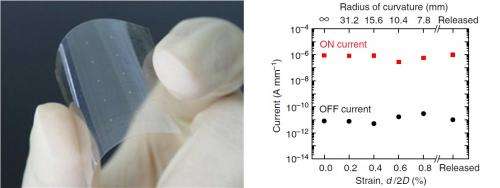August 23, 2013 feature
Plastic products could easily become electronic with first moldable all-carbon circuits

(Phys.org) —There has been a great deal of research lately on flexible electronics, but so far these devices (which are mostly made of carbon) still use metal electrodes and oxide insulators, and these rigid materials limit device flexibility. Some polymers and ionic liquids have been introduced as flexible alternatives, but have poor performance in terms of high operating voltages and low operating speeds, respectively.
In a new study, researchers have for the first time developed integrated circuits that are composed entirely of flexible carbon-based materials, and can be molded into various shapes using the same molding techniques used for shaping plastic products. The development could allow electronic circuits to be easily integrated into a variety of plastic products, including everything from medical devices to plastic products around the home.
"The plastic cases of smart phones and tablets, which are just protecting the electronic devices inside, will have electronic functions such as displays, touch sensors, and so on, making smart phones more functional and fashionable," Yutaka Ohno of Nagoya University in Japan and Aalto University in Finland told Phys.org. "By integrating other functions such as displays and sensors into plastic devices, we are thinking of developing 3D interactive information communication devices, which can be used in medical settings, for example."
Ohno, along with Dong-Ming Sun of Nagoya University and their coauthors, have published a paper on the moldable all-carbon integrated circuits in a recent issue of Nature Communications.
"The key point in our design is that the all-carbon devices are made of carbon nanotubes and polymers, and they exhibit better flexibility and stretchability compared with devices fabricated from rigid metals and oxide insulators, making the devices much more flexible and elastic," Sun said. "The results of this study make it possible to achieve a fusion of electronic devices with plastic products, which can lead to the creation of plastic electronic devices that feature both designability and functionality."

The new circuits are composed of different types of carbon materials, with the active channels and passive elements consisting of carbon nanotubes, and the dielectric layers and substrates consisting of the plastic polymers polymethyl methacrylate (PMMA) and polyethylene naphthalate (PEN), respectively.
Unlike the polymers and ionic liquids that have been previously tried as materials for flexible dielectrics, the PMMA that the researchers used here can enable transistors and integrated circuits to operate at low voltages and high speeds. The low operating voltage can be explained in part by the sparse, network-like carbon nanotube thin film used as the channels, which enhances coupling between the channel and gate electrode compared with using thick polymers as the channels.
Previously, the researchers successfully fabricated a thin-film transistor with a mobility greater than 600 cm2V-1s-1 by developing a technology for forming a long, yet pure, carbon nanotube film on plastic. In the new study, the researchers made further progress on the optimization of the film-forming technology, achieving a mobility of 1,027 cm2V-1s-1. This mobility is higher than that of a MOSFET, which uses monocrystalline silicon, and the researchers describe it as an astonishing value for a thin-film transistor fabricated on a plastic substrate.
Because these all-carbon devices are made of carbon nanotubes and polymers, they exhibit better flexibility and stretchability compared with devices fabricated from rigid metals and oxide insulators. Perhaps the most useful feature of the all-carbon circuits is their moldability, which the researchers demonstrated by heating and blowing a planar substrate to form a dome-shaped structure. The 3D dome is stretched during this molding process without cracking, in sharp contrast to rigid materials such as metals. The extreme stretchability of both the passive and active elements of the devices can allow them to be formed using the same molding techniques used today to shape plastic products.
In order to scale up the devices, the researchers note that it will be important to grow carbon nanotubes with a uniform length and diameter to minimize current variation. Eliminating metallic nanotubes can also offer further performance improvements. They also hope to use fabrication methods other than the lithographic methods they used here.
"It is desirable to form carbon nanotube channels and wirings at atmospheric pressure and low temperature by high-throughput printing techniques rather than current lithographic techniques," Sun said.
More information: Dong-Ming Sun, et al. "Mouldable all-carbon integrated circuits." Nature Communications. (2013) DOI: 10.1038/ncomms3302
Dong-Ming Sun, et al. "Flexible high-performance carbon nanotube integrated circuits." Nature Nanotechnology. (2011) DOI: 10.1038/nnano.2011.1
Journal information: Nature Communications , Nature Nanotechnology
© 2013 Phys.org. All rights reserved.





















